Sara Pankenier Weld
Visual and Verbal Self-Referentiality in Russian Avant-Garde Picturebooks
Abstract: The early Soviet picturebook arose in an age of propaganda that conceived of children’s literature as a “forgotten weapon” in the battle to train a new populace to inhabit the new post-revolutionary world. For this reason, one can detect a variety of rhetorical aims in early Soviet picturebooks. This article examines visual and verbal self-referentiality in Russian avant-garde picturebooks along aesthetic, educational, and political axes, focusing first on avant-garde self-referentiality evident in works by Vladimir Mayakovsky and Daniil Kharms that typify the avant-garde movement and then turning to picturebook self-referentiality exemplified in works by Samuil Marshak and Ilya Ionov, which reflect increasing consciousness of the picturebook as genre. It argues that avant-garde self-referentiality must be considered within a broader avant-garde context, while the peculiarities of picturebook self-referentiality in this period illustrate the establishment of the early Soviet picturebook as a new branch of culture, as well as material conditions, cultural shifts, and power consolidation after the revolution. Early Soviet picturebooks employ the child reader in building a vision of the future, although the nature of that world and of the child fit to be its citizen diverges widely, showing how this time period represented a significant aesthetic and political crossroads.
Keywords: self-reference, metatextuality, metalepsis, visuality, rhetoric, Soviet, children’s literature, ideology, politics, aesthetics
Published: 23 December 2019
©2019 S. Pankenier Weld. This is an Open Access article distributed under the terms of the Creative Commons Attribution-Noncommercial 3.0 Unported License (http://creativecommons.org/licenses/by-nc/3.0/), permitting all non-commercial use, distribution, and reproduction in any medium, provided the original work is properly cited.
Citation: Barnboken – tidskrift för barnlitteraturforskning/Journal of Children’s Literature Research, Vol. 42, 2019 http://dx.doi.org/10.14811/clr.v42i0.421
Rhetoricians of antiquity, since Cicero in On the Orator, have identified the characteristics of an effective rhetorical product as docere (educating), delectare (entertaining), and movere (moving) the audience (cf. Cicero 280–281). The history of children’s literature, as scholars such as Seth Lerer have acknowledged, also typically vacillates between the aspirations “to teach” and “to entertain” (Lerer 11, 77). The political circumstances of post-revolutionary Soviet Russia, meanwhile, also necessitate the third component of moving the audience to provoke specific action. After all, the early Soviet picturebook arose in an age of propaganda seeking to train a new populace to properly inhabit the brave new world created by the revolution. Children’s literature, as scholars have noted (Putilova 5; Balina & Rudova 189; Hellman 20–45), was conceived of as a “forgotten weapon” (Kormchy 3) in spreading new ideology and shaping the thinking of the rising populace. For this reason these rhetorical aims can serve to illuminate the dynamics of early Soviet picturebooks in this examination of selected but telling examples of visual and verbal self-referentiality in Russian avant-garde picturebooks along aesthetic, educational, and ideological axes.1
Visual and verbal self-referentiality in Russian avant-garde picturebooks as exemplified in these examples represent two distinct types, which prove very different when examined along these tripartite parameters, underscoring how Russian avant-garde picturebooks had their heyday in a time of great contradictions. First, this article examines avant-garde self-referentiality that calls attention to the avant-garde object itself, which is evident in works by Vladimir Mayakovsky and Daniil Kharms, for example, and displays features of these unique and eccentric individuals, but also proves representative of avant-garde principles. Then it examines picturebook self-referentiality, exemplified here in works by Samuil Marshak and Ilya Ionov. Picturebook self-referentiality here refers to visual and verbal references to books, whether specific books or books in general, that in fact prove reflective of increasing consciousness of the picturebook as genre, as well as broader occurrences in material culture. Avant-garde self-referentiality must be considered within the broader context of other work by these authors and other avant-garde practitioners and predecessors, while the peculiarities of picturebook self-referentiality in this period prove illustrative of the establishment of a new branch of culture – the early Soviet picturebook – but also reflect a broader context of material conditions, cultural shifts, and the consolidation of power after the revolution. All of these books employ the child reader in building a vision of the future, although the nature of that world and of the child fit to be its citizen diverges widely, showing how this time period marked a significant aesthetic and political crossroads, whose contradictions find embodiment in these picturebooks.
Self-referentiality can also be described with the narratological term metalepsis. John Piers summarizes the narratological definitions of metalepsis offered by Gérard Genette as follows in The Living Handbook of Narratology:
In its narratological sense, metalepsis, first identified by Genette, is a paradoxical contamination between the world of the telling and the world of the told: “any intrusion by the extradiegetic narrator or narratee into the diegetic universe (or by diegetic characters into a metadiegetic universe, etc.), or the inverse […]” (Genette 1980: 234–35). Described as “taking hold of (telling) by changing level” (235 n. 51) and thus combining the principle of narrative levels […] with the rhetorical figure of metalepsis originating in ancient legal discourse, narrative metalepsis is a “deliberate transgression of the threshold of embedding” resulting in “intrusions [that] disturb, to say the least, the distinction between levels.” […] (Genette 1988: 88). Genette (2004) also argues that not only is metalepsis a violation of the separation between syntactically defined levels, but also a deviant referential operation, a violation of semantic thresholds of representation that involves the beholder in an ontological transgression of universes and points toward a theory of fiction. (Piers)
Scholars including Joe Sutliff Sanders have examined children’s metafiction, while picturebook scholars have explored the self-referentiality in verbal and visual texts, such as in Sylvia Pantaleo and Lawrence Sipe’s Postmodern Picturebooks: Play, Parody, and Self-Referentiality (2008). Like Debra Malina who states that “artistic exploitation of metalepsis has run rampant in the postmodern era” (1), picturebook scholars typically find it characteristic of the postmodern period, as reflected in the concept of Pantaleo and Sipe’s edited volume. Yet this article aims to show its far earlier prevalence in Russian avant-garde picturebooks of the 1920s. I agree, however, with Malina and Pantaleo (12–27) about metalepsis being a mutinous narrative device that obscures and collapses the boundaries between reality and fiction, although the implications and evolving context in the Soviet period are very different, as these picturebooks show.
Delectare
In the category of avant-garde self-referentiality examined herein I place the self-referentiality of works by Mayakovsky and Kharms. Indeed, moments of self-referentiality with respect to the author abound in Mayakovsky’s writings for children, as they also do in his avant-garde writings for adults, such that Mayakovsky’s eccentric and outsized personality, which is a part of his characteristic zhiznetvorchestvo (life-creation), finds reflection in both. In Mayakovsky’s Chto ni stranitsa, – to slon, to l’vitsa (Not a Page without an Elephant or a Lioness, 1928), illustrated by Kirill Zdanevich (picture 1), the opening page (picture 2) features the author himself prominently in image and text: “L’va pokazyvaiu ia / posmotrite nate: / on / sovsem ne tsar’ zver’ia / prosto predsedatel’” (“I am showing a lion, / take a look: / he / is not at all the tsar of beasts / [but] just a chairman”). The author informs the audience in this evidently post-revolutionary moment that the king of beasts deposed by revolution is now a mere council chairman. The language draws attention to the author by using the phrase pokazyvaiu ia (“I am showing”) which not only conforms to the meter, but also self-consciously foregrounds the author’s presence and enhances the fact of his demonstrating. The image further underscores this element, since a significant portion of the image features the author himself with his arm literally indicating the lion chairman. The photorealistic inset head of the author is Mayakovsky’s own, gazing straight at the viewer. It contrasts in style with the remainder of his body, which comprises a bricolage of various styles: cartoonish shoes, cut-out trousers, painted pattern and kerchief, shaded stippled sweater, and an oversized negative space handprint against the red shoulder band of the lion chairman. One should also note the book the author figure holds in his left hand, which is Mayakovsky’s own Dlia golosa (For the Voice, 1923), innovatively designed and illustrated by El Lissitzky with boldly experimental red and black typography. This intervisual and intertextual reference also signals that the playful aestheticization of this picturebook may be linked to visual and verbal avant-garde experiments for adults and in Mayakovsky’s entire oeuvre. Moreover, it displays how the collaboration of artist and poet or image and text must be considered as one iconotext whole to fully appreciate its radical aesthetics.
A broader comparative view on radical aesthetics also sheds a different light on the experiments with color and size that characterize the red and black print on this page. These draw attention to the lion chairman, as well as the authorial “I” who is narrating. The first-person pronoun of the narrator’s or authorial voice printed in red in the upper right corner of the page thus takes a significant place in the composition, just as the author does verbally and visually, instead of merely serving as an invisible presence, as is often the case. The inclusion of the author, as well as the audience addressed by the command posmotrite nate (“look here”), makes the delivery significantly more engaging and entertaining (delectare) – in the manner of a circus performance, where the author plays such an entertaining as well as edifying role. It increases the aestheticization of the image and the performative drama of the address from author to audience, just as it transforms this statement about a change in titles into aestheticized, playful, rhyming language. This further empowers the politicized post-revolutionary message through sound repetition and emphasis enacted by rhymes, as well as through a process of aestheticization that is more playful than serious. For surely it is comical to see a lion, who no longer can be king of beasts, contenting himself with being a mere chairman who presides over fellow animals from behind a diminutive desk. He calls a gathering to order by daintily ringing a bell between large black claws, which retain associations with their predatory purpose, thus offering a very different implication as well. One might also note that it is the author Mayakovsky who self-referentially serves as lion tamer and circus director here.2
In Daniil Kharms’s writings, a vivid example of avant-garde self-referentiality in picturebook form is O tom kak starushka chernila pokupala (About How an Old Lady Went Shopping for Ink, 1929), illustrated by Eduard Krimmer (picture 3). In this story, which I discuss elsewhere (Weld, Voiceless Vanguard 197–202), an old lady protagonist searches the city for ink, as the means to write a letter to her son and finally encounters a writer with the means to tell her story and give her ink. After earlier mishaps, she wends her way into an office above a bookstore in a central city building, where two writers, one fat and one thin, learn of her search. She inquires of them, “Nel’zia li mne u vas tut chernila kupit’?” (“Would it be possible for me to buy some ink here?”, Kharms, O tom kak 24). She clarifies by stating, “Chernila, kotorymi pishut” (“Ink that you write with” 24), thereby underscoring ink’s material connection to writing. Similarly, she explains her arrival to the bookstore below, by noting, “Knigi-to, chai, chernilami pishutsia” (“Books, after all, are written with ink” 26). The thin writer, who previously had been struggling with writer’s block, recognizes the creative potential of her defamiliarized perspective3 and proposes that he will write her story (27). He then addresses the old lady and says, “Rasskazhite vy nam o tom, kak vy chernila pokupali, a my pro vas knizhku napishem i chernil dadim” (“Tell us about how you went shopping for ink, and we will write a book about you and give you ink” 27). She agrees to these terms and the book itself concludes with the lines, “I vot tonkii chelovek napisal knizhku: / O TOM, KAK STARUSHKA CHERNILA POKUPALA” (“And so the thin man wrote the book: / ABOUT HOW AN OLD LADY WENT SHOPPING FOR INK”), thereby metatextually and self-referentially explaining the origin of the present book. This self-referential maneuver proves typical of Kharms’s experimental and playful writings for children, which bring children into the laboratory of fiction and of children’s literature publishing in the day.
The self-referential experiments in O tom kak starushka chernila pokupala are not limited to this metatextual self-referentiality where the story’s conclusion marks its beginning.4 In fact, subtle details in the text indicate that the location that the old lady happens to reach in her perambulations proves to be the real headquarters of children’s literature publishing in Leningrad, atop Dom Knigi, the House of the Book, located in the old Singer building in the central city (cf. Weld, Voiceless Vanguard 201). Moreover, the fat editor and thin writer in the story are in fact very specific individuals, editor Samuil Marshak and writer Daniil Kharms, as underscored by the accompanying illustration plate (picture 4). There a dark-faced profile with his typical pipe and unruly hair that resembles Kharms stands and writes the first lines of the present story on the wall, while a plump bespectacled editor resembling Marshak sits on a chair and converses with the old lady.5 No doubt, many such details might not be apprehended by a child reader, thus illustrating even more strongly how Kharms, like Mayakovsky, carries avant-garde practices for adults into his writings for children and, in fact, expects the audience, at least in part, to be one and the same. Such self-referential experiments on the verbal and visual levels of the text, which highlight the production of the text, welcome the reader into an alternative history of its creation, and bare the devices of its own making, have a distinctly avant-garde cast. They defy convention, prolong perception, offer a cognitive challenge to the reader, and deliver inside jokes that playfully heighten, highlight, and draw attention to aesthetic elements and invite the reader to participate in and take pleasure in the aesthetic process.
Theorists of narratology indeed have observed the fact that meta- lepsis signals the constructedness of narrative along the lines of Russian formalist defamiliarization (Wagner 243–248) and that metalepsis figures in the construction of Russian formalism with its laying bare of devices, highlighting the artfulness of art, and the foregrounding of form (cf. Schmid 176–179). Like these theorists, Frank Wagner and Wolf Schmid, I would argue that these forms of self-referentiality embody radical aesthetics and in this case are distinctly avant-garde and formalist in their playful deconstructions, which are motivated by purely aesthetic concerns. Yet, they are not without political implication. For example, we might think of Patricia Waugh’s widely accepted definition of metafiction as a fictional text which “draws attention to its status as an artifact in order to pose questions about the relationship between fiction and reality” and to “explore the possible fictionality of the world outside the literary fictional text” (Waugh 2). Indeed, Daniil Kharms’s radical and often subversive aesthetics, which led to his arrest and eventual death, often did highlight or reduce to absurdity the arbitrariness and fictionality of the world in which he found himself. For example, his 1930s children’s poem “Na etoi stranitse” (“On This Page…”), which is seemingly about the wonders of fiction, also concludes with the potentially subversive declaration: “Bumazhnaia etо strana” (“This country is made of paper”).
Docere
The next two works display a different line of development, which leads not toward aesthetic radicalism and entertainment, but toward a truly Soviet picturebook, dominated by a didactic impulse that foregrounds the labor behind books and the young reader’s attention to its production process. These picturebooks prove less of a continuation of avant-garde experiments in other genres and for other audiences, and rather point toward an ideologically and didactically determined future without questioning the ontological status of the world. These books do not refer to the author or the creative process behind the picturebook in question, but to a collective body of picturebooks and the labors and manufacturing that go into their creation. In some sense, these, in an echo of avant-garde principles, also bare the devices of picturebook production, insofar as they expose the production process. Yet this is not a playful, aestheticized, and avant-garde baring of devices; it instead represents a materially focused view of labor and manufacturing that aims to inform and shape the audience into one correct way of being. It does not highlight the fictionality of that world but solidifies it. In this sense, these picturebooks may be considered alongside the claim of Boris Groys in The Total Art of Stalinism: Avant-Garde, Aesthetic Dictatorship, and Beyond (1992) about the continuity between avant-garde aesthetics and socialist realism of the Stalinist period, since they mark a continuation of some avant-garde principles, even as they reorient to new ideals, such as labor.
Although Ionov’s Topotun i knizhka (Topotun and the Book, 1926), illustrated by Mikhail Tsekhanovsky (picture 5), visually boasts a radical avant-garde aesthetic inspired by precursors like Vladimir Lebedev, whom it references specifically in its imagery, the verbal content of the story lacks playful, aesthetic, or entertaining content. It aims mainly to instruct (docere), as it tells the story of an errant boy who learns to respect books by being imaginatively transported into a book-printing factory by a robot. Here the radical aesthetics of imagery are somewhat divorced from the didactic content, although both reflect on the making of picturebooks. In the book, the boy’s errant ways are rapidly reformed, as vivid images display. Interestingly, even when the opportunity for a self-referential mise en abyme presents itself in multiple scenes where children are reading books, the books’ pages are merely shown as blank (picture 6). Although depicting a cult of literacy and almost holy reverence for the power of books to enlighten and reform, the blankness of these pages unintentionally also hints at erasure or a kind of inculcating of a new generation using a slate wiped clean of the errors of the past.
At the end of the picturebook, when the protagonist Tolya is shown looking at a page of a book depicting the robot in the story (picture 7), this image does not in fact offer visual self-reference to a specific aspect or illustration in the book itself. Despite the avant- garde elements of its imagery, or its subject – the making of picturebooks – the picturebook does not offer an entry point into the aesthetic process or construction of this particular book itself, even though the verbal levels of the text refer self-referentially to the manufacture of picturebooks. Its self-referential aesthetic, with its playful potential, thus capitulates to an educational mission, responding to another strong trend in this period when radical aesthetics are becoming increasingly subordinated to ideology and didacticism.
At the same time, however, the illustrations do offer numerous instances of intervisual referentiality to other picturebooks and visually exciting imagery of the period. These include book covers by illustrators Vladimir Lebedev and Vladimir Konashevich, and to other works by Mikhail Tsekhanovsky, which amount to self- referential visual references on the part of the illustrator to himself (picture 8). These abundant visual references show the book’s aesthetic continuity with the avant-garde style of illustration, even as the verbal content starts to tack another course toward didacticism. Topotun i knizhka thus clearly conceives of itself as a part of a picturebook movement that already exists and to which it might engage intervisually in this manner. Yet perhaps this becomes an echo chamber, referring only to itself, and not accomplishing innovation within its radical avant-garde aesthetics, but rather repeating the innovations of the past, even as its time is rapidly coming to an end.
The book’s verbal self-referentiality, which engages in the manufacture of picturebooks and helps to reform (docere), rather than to entertain (delectare), the young protagonist (or reader), is restricted to its treatment of the labor behind and manufacturing of books. It teaches the proper care of picturebooks by instilling respect for the process of their creation. Here the book itself self-referentially is given a voice, through the robot Topotun, and speaks its message to the protagonist and child reader: “Kniga liubit chistotu, / Chistotu. / Ugolki ne zagibai, / Ne marai. / Esli budesh’ nas chitat’ / Budesh’ mnogo znat’” (“A book loves cleanliness, / Cleanliness. / Don’t turn down its corners / Don’t sully it. / If you will read us / You will know a lot”). This book thereby teaches the proper care of books, in the voice of a pedagogue. Despite its visually arresting imagery of machines and robots (picture 9), it represents no avant-garde baring of devices or entry into the process of construction of the picturebook itself despite treating the manufacture of books. Instead it offers a very didactic message grounded in a story of a boy who does not treat books properly and therefore damages them, but learns from the robot Topotun how picturebooks are manufactured. The boy then reforms his ways and becomes a respectful reader and proper citizen-robot himself.
Treating images and text separately, however, exposes the extent to which this very didactic story functions on a more aesthetically radical level through the imagery, so that image and text work at cross-purposes, with the text promoting a didactic message while the imagery still celebrates avant-garde aesthetics for their own sake. Although the verbal narrative rarely reaches a playful level despite the potential of its self-referential subject (with the awe before the hum of the machine rendered in repetitive sound poetry being one exception), the visual narrative frequently offers striking avant-garde imagery giving entrance into the construction of the robot, for example, or of machinery in the factory (picture 10). Visually the book is considerably more playful than it is verbally and remains resolutely avant-garde, even as the text proves to be didactic and socialist realist in its devotion to praising manufacturing and proper behavior in its target audience. The text self-consciously schools the schoolboy, who is indeed reformed and learns to value the labors of others, but the images still tell another story. For example, at the very beginning of the book Tolya’s ink-stained fingers (picture 11), which recall the drafting tools depicted on the title page of the book immediately preceding this image (picture 12), show that the apparent destruction of the picturebooks displayed in the beginning of the book may have come from an artistic, aesthetic, and creative impulse. If so, this creative impulse is also being quashed by the overbearing Soviet didacticism of the book, which brooks no dissent and spells the end of the avant-garde aesthetic still visually in evidence here. In this sense, the machine defeats the human body, which loses its own creative ability as a result, even as the machine is being visually aestheticized in avant-garde fashion by the artist illustrating the book, who clearly still feels a part of a broader Russian avant-garde picturebook movement, as visual references demonstrate. But this dialogue would be cut short and Tsekhanovsky, who came late to avant-garde picturebook design, would soon have to seek creative outlets elsewhere, including in animation, where his creative career still could continue.
Movere
If Topotun i knizhka displays the theme of the destruction of books within the didactic context of revealing the process of their manufacture and instilling proper respect for books and the labor behind them, then Samuil Marshak’s Knizhka pro knizhki (A Book About Books, 1927) displays the pedagogical aim within its own self-referential focus on picturebooks (picture 13), but without the enticing avant-garde illustrations of Tsekhanovsky or a possible path of reform shown to the errant individual/child. Illustrated by Sergei Chekhonin, Knizhka pro knizhki tells a similar story of a protagonist who disrespects and destroys books and then suffers for it, producing a useful affect in the audience (movere) that might motivate them to pursue a better course of action. It might be noted that here too the errant boy has dared to create things of his own: “A v grammatike izmiatoi / Na stranitse tridtsat’ piatoi / Narisovan trubochist!” (“While in the damaged grammar book / On page thirty-five / A chimney sweep is drawn!”), while defacing the book or resisting its teachings. In this sense, the creative impulse being celebrated in the earlier metatextual books discussed here seems to be stifled in these later books, which didactically push conformity.
In Knizhka pro knizhki books also speak out self-referentially in their own defense. They answer the call of “The Brothers Grimm,” who declare, “Vot chto, knizhki, ubezhim!” (“Here it is, books, we’ll run away!”). Subsequently, the abused books revolt against the boy, as in the similarly revolutionary uprising of things in Korney Chukovsky’s famous poem “Moidodyr” (“Wash’emclean”, 1923), illustrated by Konashevich and intervisually referred to in Topotun i knizhka. Yet in this case, the story ends badly for the boy, whose quest for his missing exercise book meets with no success. On the penultimate page, we read “Ostaetsia – s mosta v reku / Il’ bezhat’ v biblioteku” (“All that’s left – [is to jump] from the bridge into the river / Or to run to the library,” Marshak). Yet, in the final image, at the library, the authoritarian figure of the catalogue book frowns at the boy, as does the stern lady librarian, while the text details their unproductive encounter: “Govoriat, v chital’nyi zal, / mal’chik malen’kii vbezhal / I sprosil u strogoi teti: / ‘Vy tut knigi vydaete?’ / A v otvet so vsekh storon / Zakrichali knizhki: Von!” (“They say, in the reading room / a little boy ran in / And asked the stern lady: / “Do you lend out books?” / And in answer from all directions / All the books yelled out: Scram!”). The uprising of things, or revolution, thus does not end, and the boy is forever dispossessed of his mistreated books and exercise books without mercy or a chance to reform, in a scene designed to emotionally move the child reader to act rightly, in contrast to this errant individual for whom all hope is lost. Apparently the boy’s only choice now is to jump “from the bridge into the river”! By this point, the didactic picturebook is unforgiving and insists, by whatever means and at whatever cost, on instilling the right behavior in its audience of children and to move them through the errant child protagonist’s counter-example and the book’s punitive message.6 The book self-referentially declares autonomy and books collectively stage a revolt against those who disrespect them. Under the authority figure of the catalogue book, who in this way resembles the robot Topotun, the law is being laid down for children, whose own revolutionary impulse must be quashed (picture 14).
Despite the book’s self-referentiality, then, it does not allow children into the creative process or allow them to create for themselves on the pages of books. There is only one proper way to be and behave, while the task of the Soviet picturebook is to move the reader rhetorically to take the one right course of action. If the book self-referentially refers to books, it is not to take delight in the aesthetic process (delectare) or even to show how things are made (docere), but only to refer to other things or people, whom it seeks to motivate to act in the proper way, as delineated by the arch-book, particularly by the fear it evokes (movere) through its collective denunciation of the errant child/individual. Here is the birth of the total art of Stalinism from the spirit of the avant-garde (cf. Groys), since the baring of devices and materiality of the book has gone from being aesthetically motivated to being ideologically proscribed.
Conclusion
If the revolt of things evident here, which is undertaken on behalf of battered books, unintentionally recalls the revolutionary uprising and unrest in Russia in the preceding period, then it is also tempting to historicize these self-referential books about books that display the destruction of books. Perhaps these scenes of damaged and destroyed books, though here attributed to ignorant children, actually involuntarily bear witness to the destruction of the past and its cultural products (without the possibility of reform) that revolution also has entailed, or to the impact of increasing censorship in this era. While a revolutionary spirit and revolt of things might still have persisted in the heyday of early Soviet picturebooks, clearly the reader, artist/writer, individual, or child faces a loss of possibilities moving forward and in complying with an increasing ideological directive. There is no revolt, play, or creativity open to children anymore, only conformity. A revolutionary spirit thus also is being quashed in the hearts of children, who do not necessarily by nature respect things as they are, but must be engaged, taught, and moved to act rightly by the rhetoric of picturebooks and propaganda, which now begin to converge along a unitary political axis.
No longer could the early Soviet picturebook represent the revolutionary impulse of aesthetic radicalism or the playfully avant-garde deconstruction of the work of art and the inner mechanics of the creative process, which give a place to creativity and to children as subversive revolutionaries and compatriots. As the latter two books discussed here indicate, the era of play (delectare) and empowerment of marginal figures was ending and the time of top-down instruction (docere) of subjects and being rhetorically moved to proper action (movere) had begun. Indeed, after the revolution, a revolutionary spirit becomes downright counter-revolutionary. As this selection of picturebooks demonstrates, the time had come for the reification and (re)construction of a brave new world according to a single vision presided over by authorities, whether robots, stern ladies, or mighty tomes. Ironically, this unitary vision is precisely what is exposed and threatened by the insights of metalepsis. As Genette observes: “the most troubling thing about metalepsis indeed lies in this unacceptable and insistent hypothesis [...] that the narrator and his narratees – you and I – perhaps belong to some Narrative” (Genette 236). Perhaps this is why avant-garde and picturebook self-referentiality would soon disappear altogether – because of its unacceptable critical potential with respect to the overarching Narrative, which was already consolidating itself in the Soviet Union in the 1920s, when these picturebooks were created, and would seize complete control over artistic production in the 1930s. In short, Soviet didacticism in children’s picturebooks required the elimination of visual and verbal self-referentiality as a literary device and meant the end of a playful attitude toward reality.
Biographical information: Sara Pankenier Weld is an Associate Professor of Russian and Comparative Literature at the University of California, Santa Barbara. She is the author of Voiceless Vanguard: The Infantilist Aesthetic of the Russian Avant-Garde (2014) and An Ecology of the Russian Avant-Garde Picturebook (2018), as well as numerous articles and book chapters on the Russian avant-garde, childhood, children’s literature, and picturebooks.
Appendix of Figures
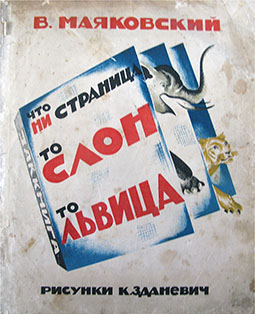
Picture 1. Cover illustration by Kirill Zdanevich for Vladimir Mayakovsky’s Chto ni stranitsa, – to slon, to l’vitsa (Not a Page without an Elephant or a Lioness, 1928). Cotsen Children’s Library, Department of Special Collections, Princeton University Library.
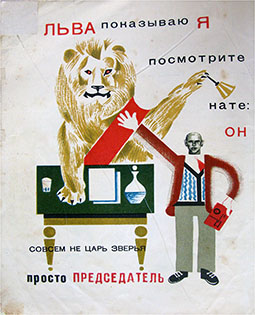
Picture 2. Illustration by Kirill Zdanevich for Vladimir Mayakovsky’s Chto ni stranitsa, – to slon, to l’vitsa (Not a Page without an Elephant or a Lioness, 1928). Cotsen Children’s Library, Department of Special Collections, Princeton University Library.
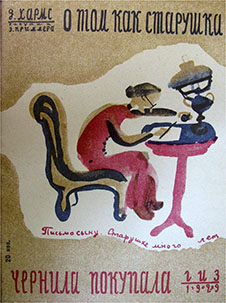
Picture 3. Cover design by Eduard Krimmer for Daniil Kharms’s O tom kak starushka chernila pokupala (About How an Old Lady Went Shopping for Ink, 1929). Cotsen Children’s Library, Department of Special Collections, Princeton University Library.
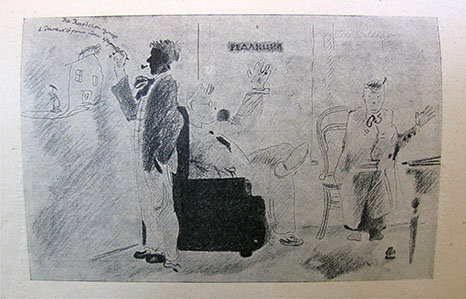
Picture 4. Illustration by Eduard Krimmer for Daniil Kharms’s O tom kak starushka chernila pokupala (About How an Old Lady Went Shopping for Ink, 1929). Cotsen Children’s Library, Department of Special Collections, Princeton University Library.
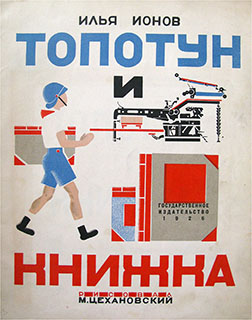
Picture 5. Cover design by Mikhail Tsekhanovsky for Ilya Ionov’s Topotun i knizhka (Topotun and the Book, 1926). Cotsen Children’s Library, Department of Special Collections, Princeton University Library.
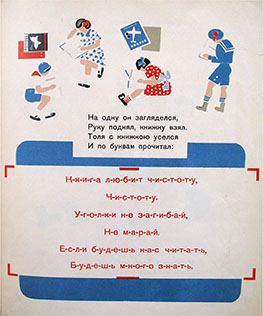
Picture 6. Illustration by Mikhail Tsekhanovsky for Topotun i knizhka (Topotun and the Book, 1926). Cotsen Children’s Library, Department of Special Collections, Princeton University Library.
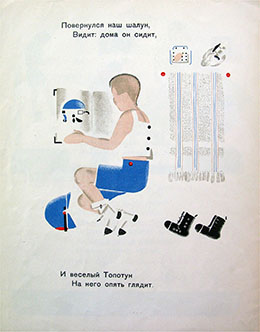
Picture 7. Illustration by Mikhail Tsekhanovsky for Ilya Ionov’s Topotun i knizhka (Topotun i knizhka 1926). Cotsen Children’s Library, Department of Special Collections, Princeton University Library.
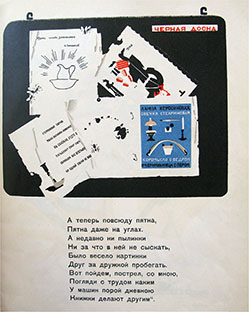
Picture 8. Illustration by Mikhail Tsekhanovsky for Ilya Ionov’s Topotun i knizhka (Topotun and the Book, 1926). Cotsen Children’s Library, Department of Special Collections, Princeton University Library.

Picture 9. Doublespread by Mikhail Tsekhanovsky for Ilya Ionov’s Topotun i knizhka (Topotun and the Book, 1926). Cotsen Children’s Library, Department of Special Collections, Princeton University Library.
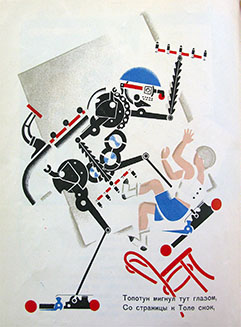
Picture 10. Illustration by Mikhail Tsekhanovsky for Ilya Ionov’s Topotun i knizhka (Topotun and the Book, 1926). Cotsen Children’s Library, Department of Special Collections, Princeton University Library.
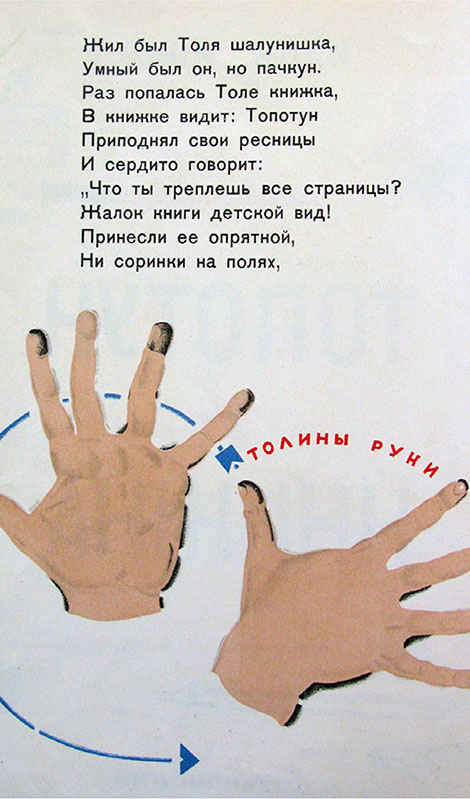
Picture 11. Illustration by Mikhail Tsekhanovsky for Ilya Ionov’s Topotun i knizhka (Topotun and the Book, 1926). Cotsen Children’s Library, Department of Special Collections, Princeton University Library.
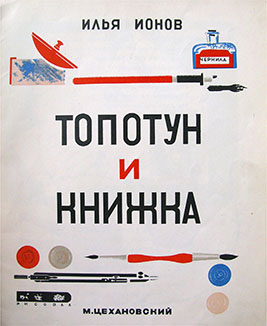
Picture 12. Title page design by Mikhail Tsekhanovsky for Ilya Ionov’s Topotun i knizhka (Topotun and the Book, 1926). Cotsen Children’s Library, Department of Special Collections, Princeton University Library.
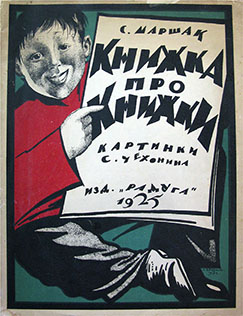
Picture 13. Cover design by Sergei Chekhonin for Samuil Marshak’s Knizhka pro knizhki (A Book About Books, 1927). Cotsen Children’s Library, Department of Special Collections, Princeton University Library.
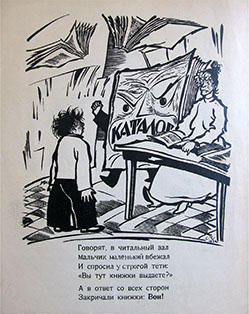
Picture 14. Illustration by Sergei Chekhonin for Samuil Marshak’s Knizhka pro knizhki (A Book About Books, 1927). Cotsen Children’s Library, Department of Special Collections, Princeton University Library.
Works Cited
Balina, Marina & Larissa Rudova. “Introduction.” The Slavic and East European Journal, vol. 49, no. 2, 2005, pp. 186–198, doi.org/10.2307/20058259.
Chukovsky, Korney. “Moidodyr” [Wash’emclean]. Stikhi i skazki. Ot dvukh do piati, edited by Valentin Berestov, Moscow, Planeta detstva, 1999, pp. 24–29.
Cicero, Marcus Tullius. On the Orator, Books 1–2. Translated by E. W. Sutton and H. Rackham, Cambridge, Harvard University Press, 1942.
Genette, Gérard. Narrative Discourse: An Essay in Method. Translated by Jane E. Lewin, Ithaca, Cornell University Press, 1980.
Groys, Boris. The Total Art of Stalinism: Avant-Garde, Aesthetic Dictatorship, and Beyond. Brooklyn, Verso, 1992.
Hellman, Ben. Fairy Tales and True Stories: The History of Russian Literature for Children and Young People (1574–2010). Leiden, Brill, 2013.
Ionov, Ilya. Topotun i knizhka [Topotun and the Book]. Illustrated by Mikhail Tsekhanovsky, Leningrad, GIZ, 1926.
Kharms, Daniil. “Na etoi stranitse” [On This Page…]. Sobranie sochinenii v 3 tomakh, vol. 3, edited by V. N. Sazhin, St. Petersburg, Azbuka, 2000, pp. 66.
---. O tom kak starushka chernila pokupala [About How an Old Lady Went Shopping for Ink]. Illustrated by Eduard Krimmer, Leningrad, Gosizdat, 1929.
---. Vo-pervykh i vo-vtorykh [Firstly and Secondly]. Illustrated by Vladimir Tatlin, Leningrad, Gosudarstvennoe izdatel’stvo, 1929.
Kormchy, Lev. 1918. “Zabytoe oruzhie” [Forgotten Weapon]. Pravda, 17 February 1918, p. 3.
Lerer, Seth. Children’s Literature: A Reader’s History, from Aesop to Harry Potter. Chicago, University of Chicago Press, 2008.
Malina, Debra. Breaking the Frame: Metalepsis and the Construction of the Subject. Columbus, Ohio State University Press, 2002.
Marshak, Samuil. Knizhka pro knizhki [A Book About Books]. Illustrated by Sergei Chekhonin, Leningrad, Raduga, 1927.
Mayakovsky, Vladimir. Chto ni stranitsa, – to slon, to l’vitsa [Not a Page without an Elephant or a Lioness]. Illustrated by Kirill Zdanevich, Tiflis, Zakkniga, 1928.
---. Dlia golosa [For the Voice]. Illustrated by El Lissitzky, Berlin, R.S.F.S.P. GIZ, 1923.
Pantaleo, Sylvia. “Mutinous Fiction: Narrative and Illustrative Metalepsis in Three Postmodern Picturebooks.” Children’s Literature in Education, vol. 41, no. 1, 2010, pp. 12–27, doi.org/10.1007/s10583-009-9096-x.
Pantaleo, Sylvia J. and Lawrence R. Sipe, editors. Postmodern Picturebooks: Play, Parody, and Self-Referentiality. New York, Routledge, 2008.
Piers, John. “Metalepsis.” The Living Handbook of Narratology. 2011 Revised version uploaded in 2016, https://www.lhn.uni-hamburg.de/node/51.html. Accessed August 1, 2018.
Putilova, Evgeniya. Ocherki po istorii kritiki sovetskoi detskoi literatury: 1917–1941 [Essays on the history of criticism of Soviet children’s literature: 1917–1941]. Moscow, Detskaia literatura, 1982.
Sanders, Joe Sutliff. “The Critical Reader in Children’s Metafiction.” The Lion and the Unicorn, vol. 33, no. 3, 2009, pp. 349–361, doi.org/10.1353/uni.0.0468.
Schmid, Wolf. Narratology: An Introduction. Berlin, de Gruyter, 2010.
Wagner, Frank. “Glissements et déphasages: note sur la métalepse narrative.” Poétique, vol. 33, no. 130, 2002, pp. 235–253.
Waugh, Patricia. Metafiction: The Theory and Practice of Self-Conscious Fiction. New York, Routledge, 1984.
Weld, Sara Pankenier. An Ecology of the Russian Avant-Garde Picturebook. Amsterdam, John Benjamins, 2018.
---. Voiceless Vanguard: The Infantilist Aesthetic of the Russian Avant-Garde. Evanston, Northwestern University Press, 2014.
Notes
1 This article does not aim at a comprehensive examination of early Soviet picturebooks, but rather lifts forward provocative examples of visual and verbal self-referentiality whose closer examination proves indicative in the context of this topic. For more detailed and contextually elaborated examinations of these and other examples, see, for example, my earlier books Voiceless Vanguard: The Infantilist Aesthetic of the Russian Avant-Garde (2014) and An Ecology of the Russian-Avant-Garde Picturebook (2018). Throughout this article the United States Library of Congress Russian transliteration system is used to render original Russian texts.
2 For this and other observations and suggestions I am grateful to my anonymous peer-reviewers.
3 In this sense the story may be compared to Marshak’s famous 1930 poem “Vot kakoi rasseiannyi…” (Look how absent-minded…”), which also features a hero at loss in everyday life and uses this infantilizing of an adult to create a story where children can feel superior.
4 In its circularity, O tom kak starushka chernila pokupala employs a structure reminiscent of nursery rhymes, lullabies, and folk forms, while it also anticipates future self-referential experiments in children’s literature, such as in Michael Ende’s The Neverending Story (1979), where the book itself figures in the story.
5 Yet one might note differences as well, including the fact that the thin writer, unlike Kharms, wears spectacles which he symbolically removes and puts on, while the fat writer, unlike Marshak, has written a story about a frog. Moreover, it may have been the artist’s choice to make this particular visual reference, although the textual conclusion of the story also certainly links it to its actual author, Kharms. This playful visual reference might be compared to the profile and overall aspect resembling Kornei Chukovsky that an informed eye might recognize in Vladimir Tatlin’s illustrations to Kharms’s Vo-pervykh i vo-vtorykh (Firstly and Secondly, 1929), especially considering Chukovsky’s prodigious height.
6 By contrast, a postwar edition of this book does give him a chance to reform by adding a new ending where the naughty boy has grown up and has not only a well-arranged library of his own, but also a well-bred son who respects books.